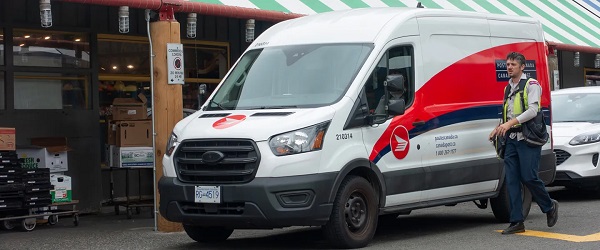Business
Tips From Tundra – Optimize Your Resume For ‘The New Normal’

The landscape of employment for job-seekers has changed dramatically since the beginning of the pandemic in Alberta. As of May 2020, the Alberta Government reports an unemployment rate of 15.5%. Combine that with experienced employees furloughed from various sectors, new graduates and those seeking a new career direction may have a steeper hill to climb than before. We continue to discover what is the new normal for Alberta post-pandemic, we revisit the topic of how to put your best foot forward when optimizing your resume for your job hunt.

Tundra Technical Solutions is a global recruitment agency headquartered in Toronto, Ontario. Since 2004, Tundra has grown quickly, today operating offices across North America, Europe and Asia. They work with top global partners actively seeking the best talent in multiple sectors such as finance, insurance, healthcare, technology, retail, energy, utilities, construction, mining, telecommunications, transportation and government to name a few.
Ever considered utilizing the skills a recruitment agency may have to offer? It may be the right time considering the volume of applicants in the hundreds on certain job postings, as shown in the image below. We spoke with Christina Esposito, Marketing and Communications Lead and Internal Recruiter for Tundra Technical Solutions on ways to optimize your resume for recruiters in the new normal.

(Source: LinkedIn Job Search)
Should your resume be written chronologically or functionally?
The key difference here is whether or not your work experience should be written as a timeline of your previous positions or should it be laid out in the form of what experience you feel is best suited for the position you are applying for. From a recruiters perspective, Christina mentions:
“We like to see a reverse chronological order of previous work experience. We recommend placing all of your technical skills right at the top of your resume, and then go into your most recent experience.”

Should you tailor your resume for the specific job you are applying for?
Say you are actively applying to open positions, tailoring your resume can be a time consuming task if your objective is to apply to the first 10-20 open positions you find. To that point, applying to everything you see can be detrimental to your efforts when utilizing a recruiter. Keep in mind, there is a human processing your candidate profile, and their efforts are to find the best talent for their employers. Christina offers a recommendation that can mitigate time for both the job seeker and recruiter:
“ we absolutely want to see someone tailoring their resume that matches the job description. A good tip for someone who might not want to go through a whole overhaul, is to first make sure that the job you’re applying to is relevant to your experience, recruiters can see if you’re applying to the first jobs that pop up for example. It becomes clear they haven’t really looked into the position they’re applying for. So, a lot of care and detail should go into those applications if you want to have the greatest success. Ultimately you want to make sure that the job description lines up with your skills…”

What is the best resume format that can be read autonomously through recruitment software?
As mentioned above, some positions can receive hundreds of applications. If you haven’t been made aware by now, recruiters utilise software called an Applicant Tracking System (ATS) or what is referred to as resume parsing, which allows the hundreds of resumes to be read and processed, thus creating a candidate profile highlighting the most relevant information to send to an employer. Say you spent endless hours on the most aesthetically pleasing resume to give that ‘wow’ factor, that may have been a solid practice in the past, but ATS systems have difficulty processing these resume formats, thus your candidate profiles could be lacking important information.
“I would recommend against a PDF format. The reason being is that Microsoft Word documents are the most legible and easiest to parse with. The way the ATS works is, someone sends in the application, the ATS picks those keywords from their resume and matches them to the actual job description. Inserting images or a lot of text can make it difficult for recruiters to look up your profile in the future.”
What should NOT be included on your resume?
Some of these you may already know, but let’s be clear, having a resume with only relevant information is your best chance of success. Working as a retail store manager I had received countless resumes from individuals seeking employment. During that time, I had encountered some of the most outrageous and creative resumes from all walks of life. By no means am I a recruitment specialist, but sticking to the basics was a winner for my new hires during that time. Christina offers the perspective of a recruiter for what not to put on your resume:
“Jumping right into things like objectives or hobbies is fine, but we would recommend against it because the longer you make your resume, you can decrease the chances of someone reading the full document. Best practice is to always keep your resume one to two pages with only relevant information. For industry veterans that have lengthy work history, you should only list the most recent and relevant experience.”
Should you include links to your social media?
Social media plays a significant role in the recruitment process for both agencies and hiring managers. LinkedIn has become a major part of what we call this ‘new normal’, with more than 20 million companies listed on the site and 14 million open jobs, it’s no surprise that over 75% of people who recently changed jobs used LinkedIn to inform their career decision. When it comes to social media, Christina offers her recommendations:
“90% of the time, recruiters are looking at your LinkedIn or Twitter. We want to make sure we get a holistic view of the applicant. 40% of our hires last year were candidates we sourced directly from LinkedIn. We have situations where we have candidates that look great on paper, but after we do some investigating. He/she doesn’t actually prove to be the person he/she was saying on paper. It’s a point of validation and puts a face to a name. My recommendation would be to keep your social media profiles clean, descriptive and showcase your accomplishments, especially if you have a public profile.”
This information should offer you some insight into how the employment landscape is changing and what best practices to implement for your job hunt. Who wouldn’t want to save time and effort on what can be an arduous task?

If you would like to learn more about Tundra Technical Solutions, speak to one of their experienced recruiters or to view their available positions in Alberta, check out their website here or message them on their Facebook below.
For more stories, visit Todayville Calgary
Agriculture
Canada’s supply management system is failing consumers

This article supplied by Troy Media.
The supply management system is cracking. With imports climbing, strict quotas in place and Bill C202 on the table, we’re struggling to feed ourselves
Canada’s supply management system, once seen as a pillar of food security and agricultural self-sufficiency, is failing at its most basic function:
ensuring a reliable domestic supply.
According to the Canadian Association of Regulated Importers, Canada imported more than 66.9 million kilograms of chicken as of June 14, a 54.6 per cent increase from the same period last year. That’s enough to feed 3.4 million Canadians for a full year based on average poultry consumption—roughly 446 million meals. Under a tightly managed quota system, those meals were supposed to be produced domestically. Instead imports now account for more than 12 per cent of this year’s domestic chicken production, revealing a growing dependence on foreign supply.
Supply management is Canada’s system for regulating dairy, poultry and egg production. It uses quotas and fixed prices to match domestic supply with demand while limiting imports, intended to protect farmers from global price swings and ensure stable supply.
To be fair, the avian influenza outbreak has disrupted poultry production and partially explains the shortfall. But even with that disruption, the numbers are staggering. Imports under trade quotas set by the World Trade Organization, the Canada-United States Mexico Agreement and the Comprehensive and Progressive Agreement for Trans-Pacific Partnership are running at or near their allowable monthly share—known as pro-rata
levels—signalling not just opportunity, but urgency. Supplementary import permits, meant to be used only in emergencies, have already surpassed 48 million kilograms, exceeding total annual import volumes in some previous years. This isn’t a seasonal hiccup. It’s a systemic failure.
The system, designed to buffer domestic markets from global volatility, is cracking under internal strain. When emergency imports become routine, we have to ask: what exactly is being managed?
Canada’s most recent regulated chicken production cycle, which ended May 31, saw one of the worst shortfalls in over 50 years. Strict quota limits stopped farmers from producing more to meet demand, leaving consumers with higher grocery bills and more imported food, shaking public confidence in the system.
Some defenders insist this is an isolated event. It’s not. For the second straight week, Canada has hit pro-rata import levels across all chicken categories. Bone-in and processed poultry, once minor players in emergency import programs, are now essential just to keep shelves stocked.
And the dysfunction doesn’t stop at chicken. Egg imports under the shortage allocation program have already topped 14 million dozen, a 104 per cent jump from last year. Not long ago, Canadians were mocking high U.S. egg prices. Now theirs have fallen. Ours haven’t.
All this in a country with $30 billion in quota value, supposedly designed to protect domestic production and reduce reliance on imports. Instead, we’re importing more and paying more.
Rather than addressing these failures, Ottawa is looking to entrench them. Bill C202, now before the Senate, seeks to shield supply management from future trade talks, making reform even harder. So we must ask: is this really what we’re protecting?
Meanwhile, our trading partners are taking full advantage. Chile, for instance, has increased chicken exports to Canada by more than 63 per cent, now accounting for nearly 96 per cent of CPTPP-origin imports. While Canada doubles down on protectionism, others are gaining long-term footholds in our market.
It’s time to face the facts. Supply management no longer guarantees supply. When a system meant to ensure resilience becomes a source of fragility, it’s no longer an asset—it’s an economic liability.
Dr. Sylvain Charlebois is a Canadian professor and researcher in food distribution and policy. He is senior director of the Agri-Food Analytics Lab at Dalhousie University and co-host of The Food Professor Podcast. He is frequently cited in the media for his insights on food prices, agricultural trends, and the global food supply chain.
Troy Media empowers Canadian community news outlets by providing independent, insightful analysis and commentary. Our mission is to support local media in helping Canadians stay informed and engaged by delivering reliable content that strengthens community connections and deepens understanding across the country.
Business
Prairie provinces and Newfoundland and Labrador see largest increases in size of government

From the Fraser Institute
By Jake Fuss and Grady Munro
A recent study found that Canada has experienced one of the largest increases in the size of government of any advanced country over the last decade. But within Canada, which provinces have led the way?
The size of government refers to the extent to which resources within the economy are controlled and directed by the government, and has important implications for economic growth, living standards, and economic freedom—the degree to which people are allowed to make their own economic choices.
Too much of anything can be harmful, and this is certainly true regarding the size of government. When government grows too large it begins to take on roles and resources that are better left to the private sector. For example, rather than focusing on core functions like maintaining the rule of law or national defence, a government that has grown too large might begin subsidizing certain businesses and industries over others (i.e. corporate welfare) in order to pick winners and losers in the market. As a result, economic growth slows and living standards are lower than they otherwise would be.
One way to measure the size of government is by calculating total general government spending as a share of the economy (GDP). General government spending refers to spending by governments at all levels (federal, provincial, and municipal), and by measuring this as a share of gross domestic product (GDP) we can compare across jurisdictions of different sizes.
A recent study compared the size of government in Canada as a whole with that of 39 other advanced economies worldwide, and found that Canada experienced the second-largest increase in the size of government (as a share of the economy) from 2014 to 2024. In other words, since 2014, governments in Canada have expanded their role within the economy faster than governments in virtually every other advanced country worldwide—including all other countries within the Group of Seven (France, Germany, Italy, Japan, the United Kingdom, and the United States). Moreover, the study showed that Canada as a whole has exceeded the optimal size of government (estimated to fall between 24 and 32 per cent of GDP) at which a country can maximize their economic growth. Beyond that point, growth slows and is lower than it otherwise would be.
However, Canada is a decentralized country and provinces vary as to the extent to which governments direct overall economic activity. Using data from Statistics Canada, the following charts illustrate which provinces in Canada have the largest size of government and which have seen the largest increases since 2014.

The chart above shows total general government spending as a share of GDP for all ten provinces in 2023 (the latest year of available provincial data). The size of government in the provinces varies considerably, ranging from a high of 61.4 per cent in Nova Scotia to a low of 30.0 per cent in Alberta. There are geographical differences, as three Atlantic provinces (Nova Scotia, Prince Edward Island, and New Brunswick) have the largest governments while the three western-most provinces (Alberta, Saskatchewan, and British Columbia) have the smallest governments. However, as of 2023, all provinces except Alberta exceeded the optimal size of government—which again, is between 24 and 32 per cent of the economy.

To show which provinces have experienced the greatest increase in the size of government in recent years, the second chart shows the percentage point increase in total general government spending as a share of GDP from 2014 to 2023. It should be noted that this is measuring the expansion of the federal government’s role in the economy—which has been substantial nationwide—as well as growth in the respective provincial and municipal governments.
The increases in the size of government since 2014 are largest in four provinces: Newfoundland and Labrador (10.82 percentage points), Alberta (7.94 percentage points), Saskatchewan (7.31 percentage points), and Manitoba (7.17 percentage points). These are all dramatic increases—for perspective, in the study referenced above, Estonia’s 6.66 percentage point increase in its size of government was the largest out of 40 advanced countries.
The remaining six provinces experienced far lower increases in the size of government, ranging from a 2.74 percentage point increase in B.C. to a 0.44 percentage point increase in Quebec. However, since 2014, every province in Canada has seen government expand its role within the economy.
Over the last decade, Canada has experienced a substantial increase in the size of total government. Within the country, Newfoundland and Labrador and the three Prairie provinces have led the way in growing their respective governments.
-

 Business1 day ago
Business1 day agoLatest shakedown attempt by Canada Post underscores need for privatization
-

 Business1 day ago
Business1 day agoWhy it’s time to repeal the oil tanker ban on B.C.’s north coast
-

 Aristotle Foundation2 days ago
Aristotle Foundation2 days agoHow Vimy Ridge Shaped Canada
-

 Alberta1 day ago
Alberta1 day agoPierre Poilievre – Per Capita, Hardisty, Alberta Is the Most Important Little Town In Canada
-

 Alberta1 day ago
Alberta1 day agoAlberta Provincial Police – New chief of Independent Agency Police Service
-

 Energy1 day ago
Energy1 day agoIf Canada Wants to be the World’s Energy Partner, We Need to Act Like It
-

 MxM News1 day ago
MxM News1 day agoUPenn strips Lia Thomas of women’s swimming titles after Title IX investigation
-

 International2 days ago
International2 days agoCBS settles with Trump over doctored 60 Minutes Harris interview







